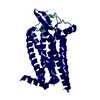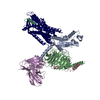+ Open data
Open data
- Basic information
Basic information
| Entry | Database: PDB / ID: 8iy5 | |||||||||||||||||||||||||||||||||||||||||||||||||||||||||||||||
|---|---|---|---|---|---|---|---|---|---|---|---|---|---|---|---|---|---|---|---|---|---|---|---|---|---|---|---|---|---|---|---|---|---|---|---|---|---|---|---|---|---|---|---|---|---|---|---|---|---|---|---|---|---|---|---|---|---|---|---|---|---|---|---|---|
| Title | ETB-Gi complex bound to endothelin-1 | |||||||||||||||||||||||||||||||||||||||||||||||||||||||||||||||
 Components Components |
| |||||||||||||||||||||||||||||||||||||||||||||||||||||||||||||||
 Keywords Keywords | PEPTIDE BINDING PROTEIN / Class A GPCR / Endothelin / Gi / Vasoactive peptide | |||||||||||||||||||||||||||||||||||||||||||||||||||||||||||||||
| Function / homology |  Function and homology information Function and homology information: / endothelin A receptor binding / rhythmic excitation / negative regulation of phospholipase C/protein kinase C signal transduction / peptide hormone secretion / endothelin B receptor binding / cellular response to human chorionic gonadotropin stimulus / meiotic cell cycle process involved in oocyte maturation / semaphorin-plexin signaling pathway involved in axon guidance / positive regulation of artery morphogenesis ...: / endothelin A receptor binding / rhythmic excitation / negative regulation of phospholipase C/protein kinase C signal transduction / peptide hormone secretion / endothelin B receptor binding / cellular response to human chorionic gonadotropin stimulus / meiotic cell cycle process involved in oocyte maturation / semaphorin-plexin signaling pathway involved in axon guidance / positive regulation of artery morphogenesis / histamine secretion / neural crest cell fate commitment / vein smooth muscle contraction / glomerular endothelium development / response to prostaglandin F / sympathetic neuron axon guidance / positive regulation of sarcomere organization / noradrenergic neuron differentiation / phospholipase D-activating G protein-coupled receptor signaling pathway / maternal process involved in parturition / positive regulation of chemokine-mediated signaling pathway / body fluid secretion / leukocyte activation / rough endoplasmic reticulum lumen / positive regulation of renal sodium excretion / pharyngeal arch artery morphogenesis / regulation of D-glucose transmembrane transport / endothelin receptor signaling pathway involved in heart process / positive regulation of odontogenesis / epithelial fluid transport / cardiac neural crest cell migration involved in outflow tract morphogenesis / negative regulation of hormone secretion / response to ozone / Weibel-Palade body / endothelin receptor signaling pathway / podocyte differentiation / positive regulation of cation channel activity / positive regulation of cell growth involved in cardiac muscle cell development / response to leptin / glomerular filtration / axonogenesis involved in innervation / renal sodium ion absorption / positive regulation of smooth muscle contraction / artery smooth muscle contraction / cellular response to follicle-stimulating hormone stimulus / positive regulation of prostaglandin secretion / respiratory gaseous exchange by respiratory system / cellular response to luteinizing hormone stimulus / regulation of pH / cellular response to mineralocorticoid stimulus / basal part of cell / vasoconstriction / response to salt / positive regulation of urine volume / positive regulation of hormone secretion / regulation of systemic arterial blood pressure by endothelin / cellular response to toxic substance / embryonic heart tube development / dorsal/ventral pattern formation / cellular response to fatty acid / axon extension / cartilage development / positive regulation of neutrophil chemotaxis / prostaglandin biosynthetic process / signal transduction involved in regulation of gene expression / superoxide anion generation / negative regulation of protein metabolic process / Activation of G protein gated Potassium channels / G-protein activation / G beta:gamma signalling through PI3Kgamma / Prostacyclin signalling through prostacyclin receptor / G beta:gamma signalling through PLC beta / ADP signalling through P2Y purinoceptor 1 / Thromboxane signalling through TP receptor / Presynaptic function of Kainate receptors / G beta:gamma signalling through CDC42 / Inhibition of voltage gated Ca2+ channels via Gbeta/gamma subunits / G alpha (12/13) signalling events / Glucagon-type ligand receptors / G beta:gamma signalling through BTK / ADP signalling through P2Y purinoceptor 12 / Adrenaline,noradrenaline inhibits insulin secretion / middle ear morphogenesis / Cooperation of PDCL (PhLP1) and TRiC/CCT in G-protein beta folding / Ca2+ pathway / Thrombin signalling through proteinase activated receptors (PARs) / G alpha (z) signalling events / cellular response to glucocorticoid stimulus / Extra-nuclear estrogen signaling / G alpha (s) signalling events / nitric oxide transport / G alpha (q) signalling events / branching involved in blood vessel morphogenesis / G alpha (i) signalling events / response to dexamethasone / positive regulation of cardiac muscle hypertrophy / Glucagon-like Peptide-1 (GLP1) regulates insulin secretion / High laminar flow shear stress activates signaling by PIEZO1 and PECAM1:CDH5:KDR in endothelial cells / Vasopressin regulates renal water homeostasis via Aquaporins / response to testosterone Similarity search - Function | |||||||||||||||||||||||||||||||||||||||||||||||||||||||||||||||
| Biological species |  Homo sapiens (human) Homo sapiens (human)   | |||||||||||||||||||||||||||||||||||||||||||||||||||||||||||||||
| Method | ELECTRON MICROSCOPY / single particle reconstruction / cryo EM / Resolution: 2.8 Å | |||||||||||||||||||||||||||||||||||||||||||||||||||||||||||||||
 Authors Authors | Sano, F.K. / Akasaka, H. / Shihoya, W. / Nureki, O. | |||||||||||||||||||||||||||||||||||||||||||||||||||||||||||||||
| Funding support |  Japan, 1items Japan, 1items
| |||||||||||||||||||||||||||||||||||||||||||||||||||||||||||||||
 Citation Citation |  Journal: Elife / Year: 2023 Journal: Elife / Year: 2023Title: Cryo-EM structure of the endothelin-1-ET-G complex. Authors: Fumiya K Sano / Hiroaki Akasaka / Wataru Shihoya / Osamu Nureki /  Abstract: The endothelin ET receptor is a promiscuous G-protein coupled receptor that is activated by vasoactive peptide endothelins. ET signaling induces reactive astrocytes in the brain and vasorelaxation in ...The endothelin ET receptor is a promiscuous G-protein coupled receptor that is activated by vasoactive peptide endothelins. ET signaling induces reactive astrocytes in the brain and vasorelaxation in vascular smooth muscle. Consequently, ET agonists are expected to be drugs for neuroprotection and improved anti-tumor drug delivery. Here, we report the cryo-electron microscopy structure of the endothelin-1-ET-G complex at 2.8 Å resolution, with complex assembly stabilized by a newly established method. Comparisons with the inactive ET receptor structures revealed how endothelin-1 activates the ET receptor. The NPxxY motif, essential for G-protein activation, is not conserved in ET, resulting in a unique structural change upon G-protein activation. Compared with other GPCR-G-protein complexes, ET binds G in the shallowest position, further expanding the diversity of G-protein binding modes. This structural information will facilitate the elucidation of G-protein activation and the rational design of ET agonists. | |||||||||||||||||||||||||||||||||||||||||||||||||||||||||||||||
| History |
|
- Structure visualization
Structure visualization
| Structure viewer | Molecule:  Molmil Molmil Jmol/JSmol Jmol/JSmol |
|---|
- Downloads & links
Downloads & links
- Download
Download
| PDBx/mmCIF format |  8iy5.cif.gz 8iy5.cif.gz | 245.5 KB | Display |  PDBx/mmCIF format PDBx/mmCIF format |
|---|---|---|---|---|
| PDB format |  pdb8iy5.ent.gz pdb8iy5.ent.gz | 185.2 KB | Display |  PDB format PDB format |
| PDBx/mmJSON format |  8iy5.json.gz 8iy5.json.gz | Tree view |  PDBx/mmJSON format PDBx/mmJSON format | |
| Others |  Other downloads Other downloads |
-Validation report
| Summary document |  8iy5_validation.pdf.gz 8iy5_validation.pdf.gz | 1.1 MB | Display |  wwPDB validaton report wwPDB validaton report |
|---|---|---|---|---|
| Full document |  8iy5_full_validation.pdf.gz 8iy5_full_validation.pdf.gz | 1.1 MB | Display | |
| Data in XML |  8iy5_validation.xml.gz 8iy5_validation.xml.gz | 34.9 KB | Display | |
| Data in CIF |  8iy5_validation.cif.gz 8iy5_validation.cif.gz | 55.2 KB | Display | |
| Arichive directory |  https://data.pdbj.org/pub/pdb/validation_reports/iy/8iy5 https://data.pdbj.org/pub/pdb/validation_reports/iy/8iy5 ftp://data.pdbj.org/pub/pdb/validation_reports/iy/8iy5 ftp://data.pdbj.org/pub/pdb/validation_reports/iy/8iy5 | HTTPS FTP |
-Related structure data
| Related structure data |  35814MC  8iy6C M: map data used to model this data C: citing same article ( |
|---|---|
| Similar structure data | Similarity search - Function & homology  F&H Search F&H Search |
- Links
Links
- Assembly
Assembly
| Deposited unit | 
|
|---|---|
| 1 |
|
- Components
Components
-Guanine nucleotide-binding protein ... , 3 types, 3 molecules ABC
| #1: Protein | Mass: 40415.031 Da / Num. of mol.: 1 Source method: isolated from a genetically manipulated source Source: (gene. exp.)  Homo sapiens (human) / Gene: GNAI1 / Production host: Homo sapiens (human) / Gene: GNAI1 / Production host:  |
|---|---|
| #2: Protein | Mass: 40470.105 Da / Num. of mol.: 1 Source method: isolated from a genetically manipulated source Source: (gene. exp.)   |
| #3: Protein | Mass: 7563.750 Da / Num. of mol.: 1 Source method: isolated from a genetically manipulated source Source: (gene. exp.)   |
-Antibody / Protein / Protein/peptide , 3 types, 3 molecules ERL
| #4: Antibody | Mass: 27720.795 Da / Num. of mol.: 1 Source method: isolated from a genetically manipulated source Source: (gene. exp.)   |
|---|---|
| #5: Protein | Mass: 67492.219 Da / Num. of mol.: 1 Source method: isolated from a genetically manipulated source Source: (gene. exp.)  Homo sapiens (human) / Cell line (production host): sf9 / Production host: Homo sapiens (human) / Cell line (production host): sf9 / Production host:  |
| #6: Protein/peptide | Mass: 2497.951 Da / Num. of mol.: 1 / Source method: obtained synthetically / Source: (synth.)  Homo sapiens (human) / References: UniProt: P05305 Homo sapiens (human) / References: UniProt: P05305 |
-Details
| Has protein modification | Y |
|---|
-Experimental details
-Experiment
| Experiment | Method: ELECTRON MICROSCOPY |
|---|---|
| EM experiment | Aggregation state: PARTICLE / 3D reconstruction method: single particle reconstruction |
- Sample preparation
Sample preparation
| Component | Name: Complex of Endothelin-1, ETB, Gi trimer and scFv16 / Type: COMPLEX / Entity ID: all / Source: MULTIPLE SOURCES |
|---|---|
| Source (natural) | Organism:  Homo sapiens (human) Homo sapiens (human) |
| Buffer solution | pH: 8 |
| Specimen | Conc.: 8 mg/ml / Embedding applied: NO / Shadowing applied: NO / Staining applied: NO / Vitrification applied: YES |
| Specimen support | Grid material: GOLD / Grid mesh size: 300 divisions/in. / Grid type: Quantifoil R1.2/1.3 |
| Vitrification | Cryogen name: ETHANE |
- Electron microscopy imaging
Electron microscopy imaging
| Experimental equipment |  Model: Titan Krios / Image courtesy: FEI Company |
|---|---|
| Microscopy | Model: FEI TITAN KRIOS |
| Electron gun | Electron source:  FIELD EMISSION GUN / Accelerating voltage: 300 kV / Illumination mode: FLOOD BEAM FIELD EMISSION GUN / Accelerating voltage: 300 kV / Illumination mode: FLOOD BEAM |
| Electron lens | Mode: BRIGHT FIELD / Nominal magnification: 105000 X / Nominal defocus max: 1600 nm / Nominal defocus min: 800 nm / Cs: 2.7 mm |
| Image recording | Average exposure time: 2.3 sec. / Electron dose: 50 e/Å2 / Film or detector model: GATAN K3 (6k x 4k) / Num. of real images: 10408 |
- Processing
Processing
| EM software | Name: PHENIX / Category: model refinement | ||||||||||||||||||||||||
|---|---|---|---|---|---|---|---|---|---|---|---|---|---|---|---|---|---|---|---|---|---|---|---|---|---|
| CTF correction | Type: PHASE FLIPPING AND AMPLITUDE CORRECTION | ||||||||||||||||||||||||
| 3D reconstruction | Resolution: 2.8 Å / Resolution method: FSC 0.143 CUT-OFF / Num. of particles: 260085 / Symmetry type: POINT | ||||||||||||||||||||||||
| Refinement | Resolution: 2.8→148.74 Å / Cor.coef. Fo:Fc: 0.817 / SU B: 14.414 / SU ML: 0.28 / ESU R: 0.338 Stereochemistry target values: MAXIMUM LIKELIHOOD WITH PHASES Details: HYDROGENS HAVE BEEN ADDED IN THE RIDING POSITIONS
| ||||||||||||||||||||||||
| Solvent computation | Solvent model: PARAMETERS FOR MASK CACLULATION | ||||||||||||||||||||||||
| Displacement parameters | Biso mean: 119.348 Å2 | ||||||||||||||||||||||||
| Refinement step | Cycle: 1 / Total: 9077 | ||||||||||||||||||||||||
| Refine LS restraints |
| ||||||||||||||||||||||||
| LS refinement shell | Resolution: 2.8→2.873 Å / Total num. of bins used: 20
|
 Movie
Movie Controller
Controller




 PDBj
PDBj























